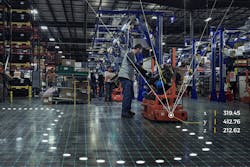If manufacturers truly want a flexible factory, some of the “things” that make up the Industrial Internet of Things (IIoT) must be able to move around freely—including robots, cranes, drones and automated guided vehicles (AGVs). With that in mind, a Boston-based company is pioneering a microlocation technology that, the company says, will “revolutionize how people and machines locate, navigate and collaborate in a connected world.”
Last week at the International Manufacturing Technology Show (IMTS ), Humatics Corporation announced its Spatial Intelligence Platform, which leverages a combination of radio frequency (RF) beacons, mobile sensors and software to create ultra-precise positioning that enables robots and industrial equipment to autonomously navigate through complex environments.
The company—co-founded in 2015 by David Mindell, a professor of aeronautics and astronautics at the Massachusetts Institute of Technology (MIT), and Gary Cohen, a technology executive, lawyer and intellectual property strategist—is on a mission to change the way people and next-generation manufacturing equipment work together by allowing machines to sense their surroundings.
The Humatics technology can track the position of objects to determine the 3D location with millimeter-scale precision at 30 m or with precision of 2 cm at distances up to 500 m. Mindell has an extensive background in oceanographic expeditions, where he developed spread-spectrum sonar technologies for undersea navigation. The microlocation platform takes similar tracking technology to the land, promising to be a disruptive force in industrial applications.
“Other localization approaches like lidar, magnetic tape, inductive RFID and GPS offer partial solutions, but each has limitations,” Mindell said. “GPS doesn’t work indoors and its accuracy is poor. Tape and inductive RFID can’t support dynamic routing. Tape wears out quickly and must be frequently maintained or replaced, while RFID is expensive and disruptive to install. Lidar doesn’t work outdoors or in unstructured or highly dynamic environments, struggles with floor height changes including ramps, and is complex and expensive.”
The Humatics Spatial Intelligence Platform overcomes these challenges with three major advancements to the industry. First, it enables effortless route changes without remapping or infrastructure adjustments. Next, it works in both indoor and outdoor environments, in all weather conditions. Finally, it allows for navigation in open and constantly changing environments, where vision systems degrade.
According to Mindell, the Humatics KinetIQ RF devices synthesize time-of-flight measurements with inertial sensors to determine the 3D location of an AGV. Stationary units, or beacons, can be easily installed in a constellation on ceilings, walls or poles, where they enable a location fix on mobile rangers mounted on the AGV.
The first offerings of the Humatics Spatial Intelligence Platform, available later this year and early 2019, include:
- The KinetIQ 300 system, which localizes mobile objects in 2D and 3D with 2 cm of precision at ranges up to 500 m.
- The KinetIQ 100 system which measures distances with 2 cm of precision at ranges up to 500 m.
- And the KinetIQ OS, a suite of spatial intelligence software providing provisioning, monitoring and data analytics services along with an extensible API.
The Spatial Intelligence Platform will be suitable for a variety of applications, including industrial vehicle tracking, tool tracking, crane positioning, drone navigation, rail signaling and other IIoT applications. But the first place it is taking hold is in AGV and mobile robot navigation.
To that end, Humatics also announced strategic partnerships with Eckhart, Shanghai Zhenhua Heavy Industries (ZPMC) and Balluff, creating an ecosystem of organizations committed to the Spatial Intelligence Platform for mission-critical Industry 4.0 applications.
“We see great potential in Humatics’ microlocation technology,” said Norbert Popp, vice president of product management at Balluff, a sensor manufacturer. “The ability to precisely and wirelessly locate objects at distances beyond 1 m is a difficult challenge in today’s industrial environments. We look forward to partnering with Humatics to solve applications in material handling and intralogistics vehicles, including mobile robots, AGVs, lift trucks and cranes.”
In addition, industrial engineering and integrator Eckhart and ZPMC, a maker of cranes and heavy-duty equipment, will integrate the Spatial Intelligence Platform into their existing and future AGV systems.
“We are currently working with the Humatics KinetIQ 300 solution,” said Haisheng Yang, general manager of the Smart Solutions Group at ZPMC. “Its high precision and performance capability in all weather conditions have immense potential to bring new levels of automation and efficiency to ZPMC’s container shipping equipment and services worldwide.”
According to Mindell, the Humatics microlocation technology represents a new opportunity for industrial automation.
“Our technology addresses a fundamental challenge in the connected world—how to locate an object within centimeters or millimeters of where it needs to be or in proximity to a person,” he said. “Dramatically improving production line flexibility, increasing throughput and improving worker safety are the main benefits of our solution. Creating a virtual grid of precise positioning services will underpin flexible factories where machine tools and material handling equipment will be mobile and require precise frame coordination.”
Leaders relevant to this article:

